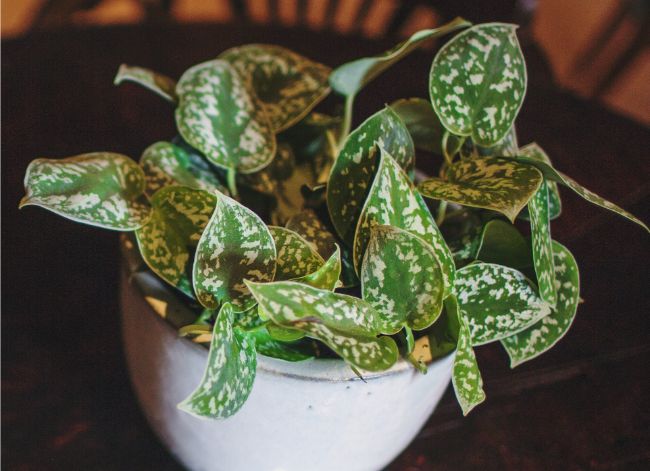With silvery dots and splashes against its dark green foliage, the satin pothos (Scindapsus pictus) is sure to grab attention wherever placed in your home. When properly cared for Satin Pothos is a hardy and relatively maintenance-free plant. Let’s start with a short summary of satin pothos care requirements.
Satin Pothos Care: Keep your Satin Pothos healthy by growing in rich, well-drained soil, fertilizing monthly and watering when the top 2-3 inches of soil becomes dry. Provide above average humidity and bright indirect light, with temperatures between 65-85°F (18-29°C).
Whether this is your first time growing Satin Pothos, or you’ve been growing the more common types for years, keep reading because we’ve taken all the guesswork out of properly caring for this tropical beauty.
Satin Pothos Care Needs
- Scientific Name: Scindapsus pictus
- Common Name: Satin Pothos or Silver Pothos
- Varieties: Scindapsus pictus ‘Argyraeus’, Scindapsus pictus ‘Exotica’, Scindapsus pictus ‘Silvery Anne’
- Origin: Scindapsus pictus originates from south east Asia. 3 main hybrid cultivars of Scindapsus pictus are sold as houseplants.
- Light Requirements: Bright, indirect light. Quite tolerant to lower light, but can start to lose its characteristic leaf markings.
- Watering: Water once the top 2-3 inches of soil is dry. Will tolerate underwatering, but much less tolerant of overwatering.
- Soil: Choose a nutrient-rich, well-draining potting mix. Any good quality houseplant potting mix will be suitable.
- Temperature: 65-85°F (18-29°C) for best growth.
- Fertilizer: Balanced, water-soluble fertilizer applied monthly through the growing season. I use this one.
- Humidity: >40% humidity. Consider getting a digital hygrometer to monitor humidity if your plant is getting brown tips.
- Pruning: Only necessary to control size and shape of your plant.
- Propagation: Propagate stem cuttings in water or moist potting mix.
- Re-Potting: Repot every 1-2 years at the start of the growing season.
- Diseases and Pests: Prone to root rot if overwatered. Spider mites and scale can occasionally be encountered.
- Toxicity: Toxic to pets and people if ingested. Can also cause skin irritation on occasion.
- Where To Buy: Buy Satin Pothos online at Etsy (I buy most of my houseplants from Etsy).
Characteristics And Origin Of Scindapsus Pictus
Satin Pothos is native to the warm and humid regions of southeastern Asia like Bangladesh, Borneo, the Philippines, Java and Sumatra. Classified as an evergreen climber, Satin Pothos can grow 10 feet tall when grown outdoors in frost-free climates, but typically grows around 3 feet tall when grown indoors either climbing up a moss stick or in hanging baskets.
The juvenile leaves are heart-shaped and as the plant matures, become pinnately lobed. Although when grown indoors the plant rarely flowers, in summer insignificant flower spathes form followed by small berries.
Satin pothos is usually sold as 3 main cultivated varieties;
Scindapsus pictus ‘Argyraeu’ is a hybrid cultivar or variety of the mother plant, with Argyraeu meaning “silvery,” which is because of the silvery markings on the foliage. The foliage edges are lined in silver and with small evenly dispersed silver spots covering the dark green leaves.
Scindapsus pictus ‘Argyraeu’ gained the Royal Horticultural Society’s Award of Garden Merit.
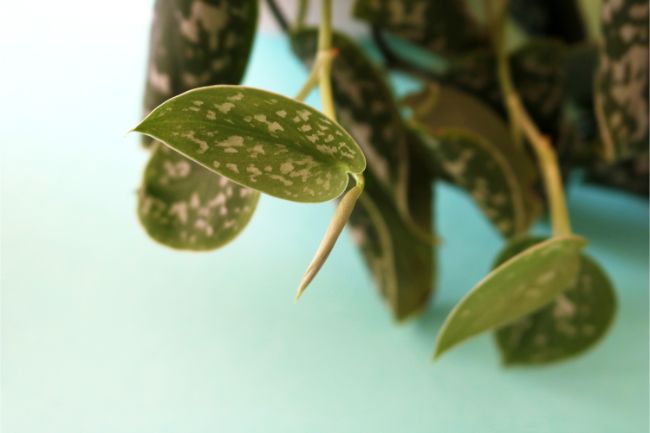
Scindapsus pictus ‘Exotica’ has larger, darker green leaves with increased variegation, but less contrast between the green background and the silvery-white leaf markings.
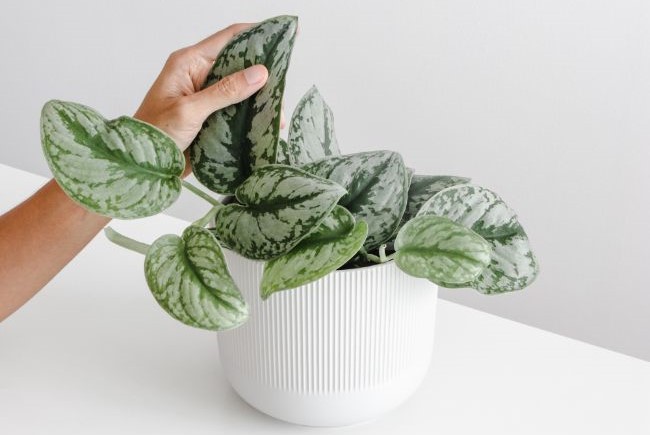
Scindapsus pictus ‘Silvery Anne’ is another hybrid cultivar with even more pronounced variegation, with some leaves almost completely white-silver.
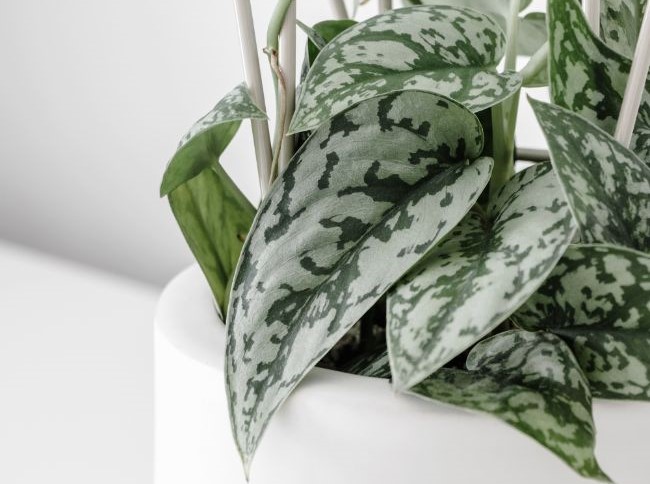
Satin Pothos Soil Requirements
Satin Pothos will do best in a rich soil mixture that has excellent drainage. The plant will not grow well planted in heavy soils that have a tendency to retain water and remain soggy for too long. In fact, you can lose your Satin Pothos when conditions are too wet due to problems with root rot.
Any good houseplant soil will be suitable for your Satin Pothos, but you can make your own by using an equal mix of peat, potting soil and perlite. If you notice your potting mix draining slowly, consider aerating the soil or add further perlite or peat through the soil to improve aeration and drainage.
Whether you decide to make your own soil mixture or go with a commercial product, the main things to remember is to make sure it drains well and has some fertility to the mix.
Light Requirements For Satin Pothos
To keep your Satin Pothos producing healthy growth, it’s best to place it in an indoor location that receives bright indirect light. It won’t tolerate receiving direct sunlight as the foliage will burn, fade and wilt.
If you position it in an area of the home that receives the direct rays of the sun, make sure there is a curtain to block some of the rays or it is positioned not directly in front of the window.
On the other hand, you don’t want to place it in a location that does not get enough light as the plant won’t produce healthy growth. Whilst satin pothos is reasonably tolerant of lower light conditions, the foliage will start to lose some of its defining silvery markings.
When outdoor temperatures warm in your area during spring and summer, you can bring your plant outdoors to give it a break from growing indoors. Just make sure you don’t place it in a sunny location or the foliage will scorch. It’s best to place it in a partially shady location and do not forget to bring it back indoors before the cool temperatures of winter arrive.
Indoor Temperature Requirements
This is a true tropical plant and even indoors, Scindapsus pictus requires a warm environment for good growth. Prime indoor temperatures that produce the healthiest growth range between 65-85°F (18-29°C).
Even when grown indoors, Satin Pothos foliage will suffer damage when temperatures drop to 60°F and below. If indoor conditions are typically comfortable for you, it’s more than likely comfortable for your Satin Pothos.

Water Requirements
When it comes to the proper amount of water to give your Satin Pothos, it’s a bit more forgiving it you forget a watering than if you overwater it, which can lead to unhealthy growth and potential plant death.
It is best to allow the top few inches of soil to dry out before you water. Use your finger to check the potting mix and if the top several inches of soil feel dry to the touch, apply water until it runs from the bottom drain holes. Another sign your plant requires a drink of water is if you see the foliage starting to curl.
If you are unsure when to water your plant, or think you may be overwatering or underwatering, you should read my article about how to check if your houseplant needs water, and this one about how often to water houseplants.
When it comes to the type of water to use, it is best to use room temperature water that has been allowed to sit out overnight. You can also use rainwater to irrigate the Satin Pothos.
Humidity Requirements
Satin Pothos thrives in the humid tropical climates of its origin, so for it to produce healthy growth indoors it requires those humid conditions being replicated. Maintaining >40% humidity will provide the best growing environment for your satin pothos.
There are several easy options to improve indoor humidity for your Satin Pothos.
- Place your satin pothos on a pebble tray. As the water evaporates around the plant, localized humidity is increased.
- Use a humidifier in close proximity to your satin pothos to boost local humidity levels.
- If your bathroom has sufficient lighting, you can grow your plant in there, as the constant use of water in the room creates a humid environment for the plant.
Brown leaf tips can be a sign of low humidity levels. Read this article to learn more about the best ways to increase humidity for your indoor plants. Consider getting a digital hygrometer if you are struggling to keep your satin pothos looking healthy.
How To Fertilize Satin Pothos
To keep your Satin Pothos producing healthy growth, it’s best to fertilize it monthly during the growing season of spring through summer. In winter, stop fertilizing until spring. You have several options of fertilizers to use.
- Use a water-soluble houseplant blend diluted to half-strength and applied monthly during active growth. This is the fertilizer I use for most of my houseplants.
- Use slow-release granules spread evenly over the soil per package directions on amounts. Slow-release fertilizers usually continue working for up to three months, slowly breaking down in the soil each time you water.
Many types of potting mixes contain a slow-release fertilizer, so you might not have to apply an additional amount for several months. However, if the Satin Pothos starts losing some of its color and it’s grown in preferred light conditions, fertilize with a water-soluble houseplant blend at half-strength.
Over time, salts contained in the fertilizer can build up in the soil and can result in browning, burned foliage on your Satin Pothos. It is a good idea to flush the soil every three to four months with water to wash the salts from the soil.
Take your plant to a sink or if it’s too large for an indoor sink and outside hose, and allow the water to slowly run through the soil for about five minutes. Allow the water to drain and then bring it back indoors.
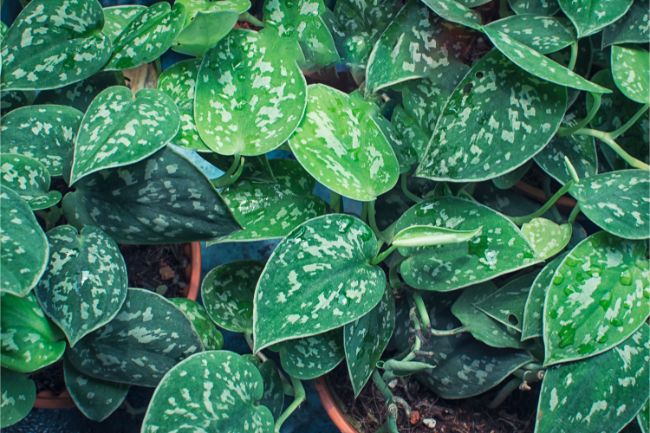
Pruning Satin Pothos
Satin Pothos needs for pruning are very low. About the only time you will need to grab your pruning snips to trim the plant is if it’s growing too long, you’d like to cut it back to make it fuller or you’d like to propagate cuttings to make additional plants.
You can also tidy up the plant by snipping off any damaged or dead leaves. The best time of year to do major pruning is when your plant starts actively growing in spring.
To keep from accidentally transferring any pests or diseases to the plant, make sure to wipe your pruning tool blades off with alcohol before using them.
Planting Tips
Satin Pothos has a relatively quick rate of growth so you will probably have to repot to freshen the soil with new each year. It is best to do major repotting when the plant goes out of dormancy in springtime through summer.
Whether you are growing it in a hanging basket, a regular container and allowing the stems to hang over the side or planting it in a container with a moss stick for it to climb upon, the task is relatively easy.
When it comes to an appropriate container, any type of material works well as long as it has bottom drainage. Bottom drainage is important because otherwise, the soil will retain too much water and you can end up with root rot problems. If your Satin Pothos has outgrown its present container, it’s best to use one that is only one size larger so there is less chance of overwatering and the soil remaining soggy for too long.
- Fill the new container about a quarter full of a rich, well-drained potting mix. Water to settle the soil.
- Gently remove the your plant from its present container, checking the root system for bunching and carefully pulling it apart, if needed.
- Place the Satin Pothos in its new container. If you are using a moss stick for it to climb upon, now is the time to insert it into the pot.
- Fill the remainder of the pot with potting mix, pressing it firmly around the moss stick, if needed and firming it around the plant’s base.
- Water the soil again and until it runs from the bottom drain holes. Place your plant in an appropriate location indoors with bright indirect light.
Propagating New Satin Pothos Plants
When you are pruning any long stems from your Satin Pothos don’t throw them away but pot them up so you get additional plants. With its attractive and unique leaf colorings, it makes a great gift idea to brighten up a friend’s home.
Using clean pruning tools snip off at least a 4-inch section and root in a glass of water, changing the water weekly or repot into a moist, peat-based potting mix. Roots should start forming on your cuttings in about four weeks. Just care for your Satin Pothos cuttings as you would the mother plant.

Disease Problems
Satin Pothos isn’t plagued by serious disease problems and the biggest problem is root rot due to the plant being overwatered or too heavy soil that remains soggy for long periods.
When root rot is a problem, the plant’s stems can become black and mushy and the foliage turns black. If the problem is just rearing its ugly head, you can cut back on watering and only irrigate when the top inch or two of soil becomes dry.
If your soil mix is too heavy, it’s best to remove the Satin Pothos from the container, gently shake off as much of the original soil as possible and repot into a clean container with a rich potting mix that has excellent drainage. Discard any stems that are mushy and black.
Pest Problems
Although rarely bothered by pests, scale and spider mites can sometimes pose a problem and it’s best to treat the problem as soon as you notice the pests. In addition, if left untreated the scales and spider mites can migrate to your other indoor plants creating even a bigger problem for you to handle. Both pests are easily identified and are treatable with the same products.
- Spider Mites: Tiny, white sap-sucking insects that spin fine webbing over the Satin Pothos. If left untreated, spider mites can quickly kill or damage the plant.
- Scale: Tiny, oblong insects that congregate along the stems in masses and suck the sap from the Satin Pothos. Scales come in a host of different colors like yellow, green, brown.
Treat both pests by covering all areas of the plant with an insecticidal soap spray or neem. Always follow the particular product’s directions on amounts and frequency of use.
Why Are My Satin Pothos Leaves Turning Brown?
Brown leaves on a Satin Pothos can be the result of two different things. If your plant is situated in full sun and receives too bright of light the foliage can burn and turn brown.
In addition, if it isn’t getting enough humidity the leaves can turn brown. Keeping your Satin Pothos in bright indirect light is best and you can increase humidity by misting the plant with room temperature water several times weekly.
Why Are My Satin Pothos Leaves Turning Yellow?
Yellowing leaves on your Satin Pothos is generally a sign you are overwatering or the soil is too heavy and retaining too much water. If your soil’s drainage is OK, cease watering until the top inch or two of soil is dry to the touch. Additionally, if the soil is too heavy and retains too much water, repot using a peat-based, rich potting mix with excellent drainage.
How To Make Satin Pothos Grow Faster?
The best thing you can do for your Satin Pothos to promote good growth is growing it in its preferred conditions and give it regular feedings. Grow in a rich, well-drained potting mix, situate in bright indirect light and in a location with temperatures of 65 to 85 degrees F, water when the top inch or two of soil is dry and feed monthly with a half-strength water-soluble houseplant fertilizer.
Why Are The Leaves Curling On My Satin Pothos?
Leaf curling on a Satin Pothos is often caused by underwatering. Water until it runs from the bottom of the pot’s drain holes when the top inch or two of soil becomes dry. During the growing season of spring through summer, you’ll probably water weekly. However, during winter while the plant is dormant you’ll probably water every couple of weeks.
Is Satin Pothos Toxic?
Satin Pothos contains calcium oxalate crystals and all portions of the plant are considered toxic to humans, dogs and cats.
Last Word
Hopefully you now have all the knowledge you need to grow a wonderfully healthy satin pothos. Get the basics right, and this is a really easy and rewarding plant to grow indoors. Happy growing.

